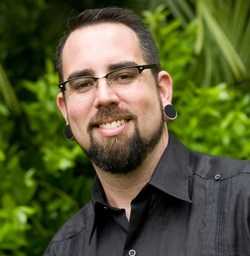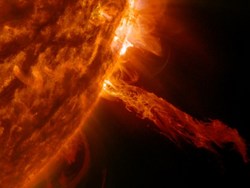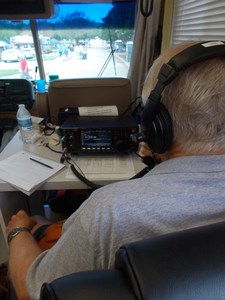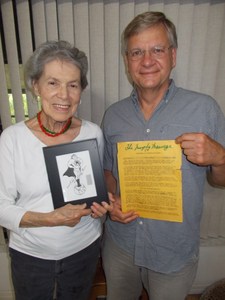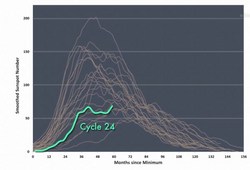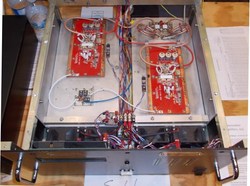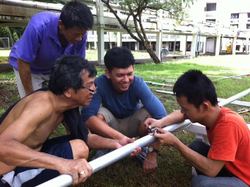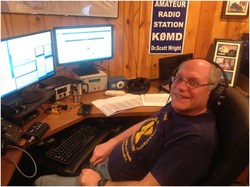 June 18, 2014 Editor: Ward Silver, NØAX | |||||||||
IN THIS ISSUE
NEW HF OPERATORS - THINGS TO DO More mid-week contesting is offered by the CWops Tests - three separate one-hour contests every Wednesday (in North America). These events have something to offer everyone, from slow-speeds through blazing fast fists. (Thanks, Hank W6SX) BULLETINS With nearly 500 logs submitted less than two days after the ARRL June VHF Contest ended, a few common issues have been noticed. For example, some participants are entering a grid square for the Cabrillo header's LOCATION: when an ARRL Section is required instead. There have also been a few logs with five-digit frequencies in the QSO: lines instead of the BAND as is specified for VHF QSOs. Make sure you review your Cabrillo-formatted log file before emailing it to the robot. Then check to be sure your log is shown properly in the Logs Received page for the contest. BUSTED QSOS Ed N1UR reports that the Orange Drop line of film capacitors is alive and well! Ed's company, SBE Inc., sold the product line to CDE a couple of years ago. There may be some confusion in the distribution change due to the change in manufacturers, but Ed says, "Buy in confidence. The parts are being made on the same equipment and with the same designs." CONTEST SUMMARY Complete information for all contests follows the Conversation section June 21-22
June 28-29
Matt Wilhelm W1MSW will become the ARRL Contest Branch Manager beginning on July 3rd. An Extra Class license holder, active contester, and a member of the Yankee Clipper Contest Club, Wilhelm has been licensed since 2009. Matt became hooked on contesting after the first ARRL Rookie Roundup in April 2010. His expertise - and contest scores - have been increasing ever since. "I cannot tell you how happy I am to be the next ARRL Contest Branch Manager," Wilhelm said. "I'll be working hard to provide the high-quality support that contest participants have come to expect from the Contest Branch." A native of eastern Texas, Wilhelm has an IT background in Help Desk operations and network security systems management. Wilhelm lives in Williamsburg, Massachusetts with his wife, Elizabeth, and their two-year-old daughter, Ruby. When not making contest QSOs, Matt enjoys mountain biking, home projects and enjoying time with his family. Recalling WRTC-1996 in which 1x 1 call signs were used for the first time in the United States, WRTC2014 teams will all use 1x1 calls from the USA first call area. Sixteen of the available 75 call signs will not be used, including the longest and shortest CW suffixes (J, Q, Y, and E) and H, a suffix frequently miscopied on CW. Note that the X suffixes are not available in this call sign series. Using this set of consistent call signs will make it easier for stations to find and work all of the WRTC stations. Following the tradition of previous WRTC events, teams will not know the call sign they will use until the referee hands them a sealed envelope just 15 minutes before the contest begins. This puts all teams at an equal starting point and helps maintain the anonymity of the teams. If you've seen any of the photos or videos of the WRTC2014 preparation - the event is only three weeks away! - you know there is a lot to manage. Who are the people in charge?
AD1C has released version 2.0 of a program to convert your W1AW Centennial Award QSOs into a spreadsheet. The new version features "a real Windows GUI program and a real Windows installer. There have been no functional changes." Support for W1AW/3 planned for Washington, D.C. in October still needs to be added. Jim says, "That will go into the next version." (Thanks, Daily DX) A busy guy lately, AD1C has also updated the Country (CTY) Files, effective June 4th. For installation instructions, hover your mouse cursor over the word Contest in the menu, then select then software you are using. To install the file, follow the link to your software at the top of the page. A bigger CTY.DAT file for everyday logging is also available. The blog of K1DG on the EDN website, "A Ham's Eye View," explains the Dayton Hamvention to an engineering audience. Attendance at Dayton was up a bit this year, despite predictions of bad weather, reaching nearly 25,000. The Hamvention has been held every year since 1952!
A NOAA video presents the case that the peak of solar Cycle 24 has, in fact, arrived. This has been a challenging cycle for prognosticators, but it does look like the cycle is beginning to wind down, the latest active sunspot notwithstanding. As with other cycles, we can expect bigger flares and magnetic storms as the cycle says farewell. (Thanks, Bob N6TV) The HAARP array in Alaska, subject of many speculative flights of fancy, is closing down in response to budget reductions. As one last hurrah, described in a recent NPR program, a researcher beamed some music skyward, creating a new composition of the spheres through nonlinear mixing, a subject hams should understand well. (Thanks, Paul KØJPL) Todd KC9BQA reports, "I've made a number of updates to www.kc9bqa.com over the past week. The new updates start on June 7th, and they are all on the "front page"." Todd's goal for the website is to help get more VHF'ers on the air. Pelican prevails again! According to the Popular Mechanics June 2014 issue's "Abusive Lab Test" for Pelican, Yeti, and Yukon coolers, the popular Pelicans proved particularly potent in protecting precious potations. Not only will they carry your radio, they can keep it cool, too! A happy fifth birthday to the Arizona Outlaws Contest Club! At the same time, a new contest club is hatched - the Wild Screaming Frogs Contesting Group, WB8WSF. "Composed of various nut cases around EN82 ± 1 grid square, our goal is to have fun, welcome all to VHF contesting, and to eventually become competent." I can't wait to see their logo. (Thanks, Bob K8IA and founding frog, Steve WB8WSF) Web Site of the Week - While the IBM PC kicked the personal computing revolution into high gear, it was the Apple II that launched it. The Apple II went on sale on June 5, 1977, and things were never the same again. WORD TO THE WISE Looking for a local Field Day or maybe you're traveling and would like to stop in and meet some local hams? Check out the ARRL Field Day Locator website where clubs or individuals provide their locations. Selected videos from the 2014 Dayton Contest University are now online. Tim, K3LR reports that for the first time in the last eight years there will be a second Contest University in the US during the year - the "CTU Centennial," July 17, 2014, in Hartford, Connecticut, as part of the ARRL Centennial celebration. The "professors" include K1DG on "ergonomics for contest stations," W3LPL on low band receive antennas on smaller lots, K3LR on multi-op contest planning, K5ZD on single op tips, and W1UE on "essentials of RTTY contesting." (Thanks, Daily DX)
The K8CX Dayton 2014 Gallery is now up with close to 4,100 Dayton photos, making this the 18th year that Tom has taken the photos. The site has Dayton photos in The Gallery back to 1971. If you have any old photos from Dayton, please send them to K8CX. Here's the exact same program that was handed out at the 22nd Annual Dayton Contest Dinner! Big thanks to Lee K7NM and his wife Judy of Photo QSLs for donating the printing of the dinner program. (Thanks, Tim K3LR) ARRL Field Day 2011 in South Louisiana is well-presented in this snazzy video with great credits! How about making one of your club's adventures this year? The ARRL January VHF Contest results have been posted with RTTY Roundup and ARRL DX CW to follow soon. Catching up a bit, records for the August UHF Contest have also been uploaded. And for those of you who think ahead, the July CQ VHF Contest lists of high scores by category and by area are posted. If you want to know whether your ARRL June VHF Contest scores are record setting, those records have been updated through 2013. (Thanks, Curt K9AKS)
The raw claimed scores for the 2014 WPX CW Contest are now available online, showing raw scores as calculated by the WPX log checking software prior to any checking. This should give participants a good indication of their category placement at the World, Continent, or Country level. Please check that your entry is in the correct category. Report any errors or questions to director@cqwpx.com. Do NOT resubmit your log to 'fix' any problems! It's not too late to send pictures or stories to be including in the final writeup. (Thanks, CQ WPX Contest Director, Terry N4TZ) The results of the 2013 WWSA CW Contest are now published. (Thanks, GACW Directors LU6UO, LU7DSU, and LU8DQ ) The SAC 2013 Result Booklet is now available, stuffed with all results and interesting stories about SAC 2013. The results include contest statistics; SAC analysis by OH2BH; CW Stories by VK8AV, DF6JC, OH1F, PJ4/G3TXF, and PY2ZEA; SSB Stories by LA3S and PA6SAC; and CW and SSB soapbox comments. Thanks especially to editor Flemming OZ8XW! (Thanks,SAC Contest Committee LB1GB, OH6KZP, OZ3ABE and SM5AJV) The 2014 Mexico RTTY Contest Results have been announced:
(Thanks, Gary AL9A ) The 2013 Triathlon DX Contest Results are online. Thanks to all for participation and congratulations to the winners. (Thanks, Kostas SV1DPI) For all bands and modes, the total CW Skimmer spot volume year-over-year is up 33% for the CQ WPX CW Contest as shown below:
That's an average of 33,001 spots per CW Skimmer receiver! (Thanks, Bob N6TV) OPERATING TIP Summertime propagation (or wintertime, if you are south of the Equator) has a variety of unique qualities. That band plan you made for CQ WW last fall - start over for the IARU HF Championship! This would be a good time to talk to veteran contesters in your club about the primary DX openings in your area. You may be surprised but better before the contest than afterward.
Cycle 24's progress and future are of considerable interest lately. Ted K8HI sent a fascinating video and article about renewed activity at the peak of the current solar cycle. If you are interested in learning the details of radio propagation, space weather, and solar phenomena, one of ham radio's propagation gurus, Tomas NW7US, is offering a self-paced course that is bundled with the ray-tracing PropLab Pro software at a bundled discount. This is a good summertime project to ramp up your propagation know-how for less than the cost of a new beam! An app for calculating guy line lengths and other requirements has been developed by the Mastrant rope company. Using a specialized calculator is a good way to avoid those hasty last-minute runs to the hardware store on the Saturday morning of Field Day. (Thanks, Tim K3LR) Do-It-Yourself satellites - an amazing concept? Not to radio amateurs who have been launching DIY birds since OSCAR 1 in 1961! Nevertheless, the Ardusats make a fascinating story and highlights ham radio, perhaps introducing a new generation of builders and makers to our fascinating realm. Aside from a few cookbook-style articles in handbooks and circuit manuals, voltage multipliers are usually just an afterthought in the power supply assembly. EDN ran a recent story detailing the interesting Cockroft-Walton voltage multiplying ladder. These are used not only to get a little more oomph for vacuum tube amplifiers but to produce the super-high voltages needed to generate beams of ionized material for particle accelerators. It turns out that not only can meteors create trails that reflect radio waves - they can emit radio waves, too! This Slashdot discussion links to the original article as well as offering up the usual potpourri of insight, explanation, and snarky techno humor.
The Mt Airy VHF Radio Club, aka "The Packrats", published their June 2014 newsletter, "Cheese Bits" with a nice article by NE3I about building small antennas for restricted housing. Good ideas for portable and temporary stations, too! New RF instrumentation is moving beyond the traditional button-and-dial-laden front panel to rely more on a companion PC for control and data storage. Learn about the latest gadgets (that will eventually become surplus and show up on our workbenches) in this EDN story. Tower maven, Don K4ZA, wrote in with an alternate method to the previous issue's description of lifting a tower's top section with mast included as a single assembly with a low center of gravity (CG). This doesn't suit every installation but might work for you - practice these more sophisticated "lifts" near the ground to see and to learn the technique before you're aloft! "Secure the mast in the tower section, using the rotator if the mast is short (only one antenna goes on). If it's a long mast, then leave the rotator out, slide the mast inside the tower section so that its top (where the top-most antenna of your stack will be mounted) extends just above the tower top. Whether short or long, insert a suitably-sized lift rope THROUGH the mast to haul up the load. Tie a knot in the rope's lower end with a large washer above that knot, resting against the lower mast end. If you are using the rotator to hold the mast, you'll have to leave room for the knot between the mast and rotator housing. Without the rotator, secure the mast by muffler clamps inside the tower section. This will keep the CG low and the load riding plumb while hauling everything up. Use a come-along to maneuver a long mast up and through the top of the tower section. Once supported by the come-along, untie the knot, and lift out the rope before lifting the mast into its final position and you won't have to climb the mast." I particularly enjoyed the Popular Mechanics June issue's article, "Why We Fix" by Kyle Wiens. As the author says, "Making something whole again expresses what it means to be human: a demonstration of our capacity to be resourceful, meet challenges, and solve problems." Game on! The new book Ten Essential Skills for Electrical Engineers by Barry Dorr is a good guide for ham radio operators, too. Even if we don't dive quite as deep as the EE folks do, having a rudimentary knowledge of these subjects makes for a more well-rounded ham. Technical Web Site of the Week - Hams and students often balk at hands-on experiences with microwave technology. It looks, feels, and behaves quite differently than RF at longer wavelengths. But with the right equipment and the right instructions, it's not so hard after all! You can begin to learn to think like a microwave by performing experiments with pre-packaged pieces and elements such as these kits being developed by Eductika that were featured at the recent IEEE International Microwave Symposium. While these kits assume a certain amount of technical infrastructure common at the university level, it's easy to see how hams could share expertise and equipment to create something similar. How about it microwave mavens? Won't You Come In? I recently received a forwarded email adapting into ham-speak the famous "Specialization is for insects" quote from Robert Heinlein's Time Enough for Love. Like the famous Lazarus Long, hams have long exhibited a certain flexibility and practicality at all levels of license. Of course, the goal of such lists should be to encourage the acquisition of these many skills and not be just another way of looking down our collective noses in order to feel superior. But I digress.
What developing this useful and effective can-do attitude does accomplish is take the beginner on a life-long journey through many different environments in the biosphere of Amateur Radio. We may enter through a particular door but the party inside is enormous! Frequency ranges that cover six orders of magnitude. Propagation that involves everything from dirt to extraterrestrial objects. Means of communication by modes Faraday would recognize as well as sophisticated codes that cleanly retrieve information buried tens of decibels below the noise. Technologies ranging from the inclined plane to quantum mechanics. All free for the taking. How do we tell this story? One opportunity is nearly upon us - Field Day! There is no other event quite like it where everybody brings their "piece" to assemble into the group station. Not only new hams learn about ham radio but so does the public - if we let them. This is one reason for so many Field Day bonus points that involve publicity and public access. With the potential of such a Field Day publicity bonanza, it's worth a little extra effort to make the most of our availability. Start by looking at your public notices. First, be sure to register your club's activities on the ARRL Field Day Locator service. You never know who will take an interest after a little Internet searching. They won't come if they don't know where you are! Next, what kind of encouragement are you giving for a non-ham to overcome their natural reluctance to pester strangers? It's not enough to put up a sandwich sign that says, "Ham Radio Field Day". Remember, they have no idea what a "Field Day" is! (Hard to imagine, I know...) How about instead, we capitalize on our many-faceted world and call it instead, "Ham Radio Open House"? Most folks understand that on two levels: first, you're inviting them in, and second, there is something to see. It might also help to advertise "Free Cookies" or the like - you'll have kids dragging their parents in by the heels to see the show.
And folks, try to look like you're glad to see visitors! Have a "greeter" assigned to show visitors around and explain what's going on. Strangers will rarely walk up and stick their noses into another group's activities - reach out to them and bring them in. Don't set up what looks like a "defensive perimeter" of fencing and canvas and cars. Sure, rope off the antennas and generators, but set up camp so that it looks like an open house and not a fortress to keep people out. How can you avoid this type of turn-off? Ask a non-ham for their objective opinion about it. Then listen - you might be surprised! Once a year, we all put on our show at the same time. There's no reason to wait for Field Day, though. Take the opportunity to put up a portable station at the mall, at playfields, at local festivals, wherever the public will be. Welcome them in - our people are out there! June 18 through July 1 An expanded, downloadable version of QST's Contest Corral in PDF format is available. Check the sponsor's Web site for information on operating time restrictions and other instructions. HF CONTESTS ARRL Field Day--Phone,CW,Digital, from Jun 28, 1800Z to Jun 29, 2100Z. Bands (MHz): 1.8-28, 50+. Exchange: Category, ARRL/RAC section or DX. Logs due: Jul 24. Rules Kid's Day--Phone, from Jun 21, 1800Z to Jun 21, 2359Z. Bands (MHz): 3.5-28. Exchange: Name, age, location, favorite color. Rules CWOps Weekly Mini-CWT Tests--CW, from Jun 18, 1300Z - See website. Multiple time periods. Bands (MHz): 1.8-28. Weekly on Wednesday, 28 to 38 kHz above band edge. Exchange: Name and member number or S/P/C. Logs due: 2 days. Rules NAQCC Milliwatt Sprint--CW, from Jun 19, 0030Z to Jun 19, 0230Z. Bands (MHz): 3.5-14. Exchange: RST, S/P/C, and NAQCC mbr nr or power. Logs due: 4 days. Rules All-Asian DX Contest--CW, from Jun 21, 0000Z to Jun 22, 2400Z. Bands (MHz): 1.8-28. Exchange: RST, operator age (YL may send 00). Logs due: Jul 31. Rules Straight Key Weekend Sprintathon--CW, from Jun 21, 1200Z to Jun 22, 2359Z. Bands (MHz): 1.8-28, 50. Exchange: RST, QTH, name, member nr if member. Logs due: 5 days. Rules Stew Perry Warmup Contest--CW, from Jun 21, 1500Z to Jun 22, 1500Z. Bands (MHz): 1.8. Exchange: 4-char grid square. Logs due: 30 days. Rules Feld-Hell Field Day Sprint--Digital, from Jun 21, 2000Z to Jun 21, 2200Z. Bands (MHz): 1.8-28. Monthly on 3rd Saturday. Exchange: RST, S/P/C, Feld-Hell member nr. Logs due: 7 days. Rules Run For the Bacon--CW, from Jun 23, 0100Z to Jun 23, 0300Z. Bands (MHz): 1.8-28. Monthly on 3rd Sunday night (local). Exchange: RST, S/P/C, Flying Pig nr or power. Rules SARL Top Band QSO Party--Phone,CW, from Jun 26, 0000Z to Jun 30, 0000Z. Bands (MHz): 1.8. Exchange: RS(T) and province or country. Logs due: 7 days. Rules His Majesty King of Spain--Phone, from Jun 28, 1200Z to Jun 28, 1200Z. Bands (MHz): 1.8-28. Exchange: RS, serial or EA province. Logs due: 15 days. Rules Marconi Memorial HF Contest--CW, from Jun 28, 1400Z to Jun 30, 1400Z. Bands (MHz): 1.8-28. Exchange: RST and serial number. Logs due: 30 days. Rules Ten-Ten Spirit of 76 QSO Party--Phone,CW,Digital, from Jun 30, 0000Z to Jul 6, 2400Z. Bands (MHz): 28. Exchange: Call, name, member number, S/P/C. Logs due: 15 days. Rules Canada Day Contest--Phone,CW, from Jul 1, 0000Z to Jul 1, 2359Z. Bands (MHz): 1.8-28, 50-144. Exchange: RS(T), Province/Territory or serial. Logs due: Jul 31. Rules VHF+ CONTESTS ARRL Field Day--Phone,CW,Digital, from Jun 28, 1800Z to Jun 29, 2100Z. Bands (MHz): 1.8-28, 50+. Exchange: Category, ARRL/RAC section or DX. Logs due: Jul 24. Rules SMIRK QSO Party--Phone,CW, from Jun 21, 0000Z to Jun 22, 2359Z. Bands (MHz): 50. Exchange: 4-char grid square and member number. Logs due: Aug 16. Rules Straight Key Weekend Sprintathon--CW, from Jun 21, 1200Z to Jun 22, 2359Z. Bands (MHz): 1.8-28, 50. Exchange: RST, QTH, name, member nr if member. Logs due: 5 days. Rules IARU 50 MHz Contest--Phone,CW, from Jun 21, 1400Z to Jun 22, 1400Z. Bands (MHz): 50. Exchange: RS(T), serial, 6-char grid locator. Logs due: 16 days. Rules WAB 50 MHz Phone--Phone, from Jun 22, 0900Z to Jun 22, 1500Z. Bands (MHz): 50. Exchange: RS, serial, WAB square or DXCC entity. Logs due: Jul 13. Rules Canada Day Contest--Phone,CW, from Jul 1, 0000Z to Jul 1, 2359Z. Bands (MHz): 1.8-28, 50-144. Exchange: RS(T), Province/Territory or serial. Logs due: Jul 31. Rules LOG DUE DATES June 18 through July 1
ARRL Information Click here to advertise in this newsletter, space subject to availability. Your One-Stop Resource for Amateur Radio News and Information ARRL membership includes QST, Amateur Radio's most popular and informative journal, delivered to your mailbox each month. Subscribe to NCJ - the National Contest Journal. Published bimonthly, features articles by top contesters, letters, hints, statistics, scores, NA Sprint and QSO Parties. Subscribe to QEX - A Forum for Communications Experimenters. Published bimonthly, features technical articles, construction projects, columns and other items of interest to radio amateurs and communications professionals. Free of charge to ARRL members: Subscribe to The ARRL Letter (weekly digest of news and information), the ARES E-Letter (monthly public service and emergency communications news), Division and Section news -- and much more! ARRL offers a wide array of products to enhance your enjoyment of Amateur Radio. Visit the site often for new publications, specials and sales. Donate to the fund of your choice -- support programs not funded by member dues! Reprint permission can be obtained by sending email to permission@arrl.org with a description of the material and the reprint publication. ACKNOWLEDGEMENTS ARRL Contest Update wishes to acknowledge information from WA7BNM's Contest Calendar and SM3CER's Contest Calendar.
| |||||||||
